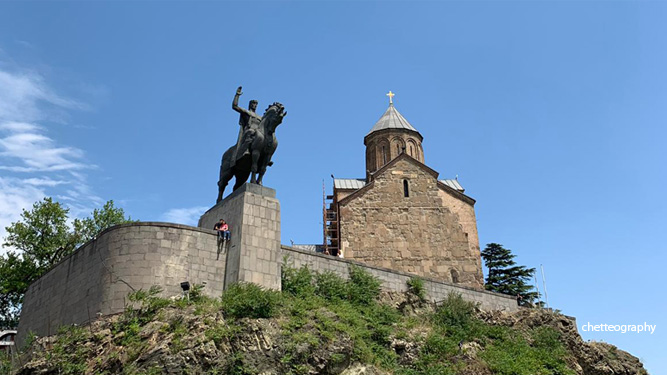
MULTICULTURAL TBILISI
Tbilisi is known for its multicultural roots and forms. This route presents religious and public venues for peoples of various faiths and ethnicities mainly concentrated in Kala and Chughureti area.
1| 20, GALAKTIONI STREET
CAUCASIAN HOUSE AND SMIRNOV MUSEUM
Smirnov Museum is located in the former residence of Empress’s Lady in Waiting Aleksandra-Rosetti built in 1860s. Her descendant Mikheil Smirnov presented the house and the relics owned by his family in the past to Georgia.
2| CATHOLIC CHURCH OF ASCENSION
Catholics started to actively visit and open their missionary activities in Georgia in the 18th c. In 1671 Capuchins built the first Catholic Church in Abesadze Street. In 1805-1808 Church of Ascension was built in the same place. In 1999 Catholics restored the church and have operated it since then.
3| MUSEUM OF JEWISH HISTORY IN GEORGIA
3, ANTON KATALIKOSI STREET.
Former Synagogue. David Baazov Museum of Jewish History in Georgia. Built in 1910. Classicistic style. The museum collections include ritual items, icons, paintings by famous Jewish artist Shalva Koboshvili, etc.
4| 41, LESELIDZE STREET.
NORASHENI
Gregorian Church of Virgin Mary. Accoding to French traveler Jean Chardin Norasheni church was built in the early half of 1670; however historians attribute construction date to 1793. The church is built of bricks in the form of a cross and is related to the Armenian and Georgian architecture of the late medieval centuries. Its façade has some traces of classicistic style. The church was painted in the 19th c. by Armenian artist Mkrtum Ovnatanian. It is the main Gregorian church in Tbilisi.
5| 4, SIONI STREET.
SIONI CATHEDRAL
Sioni Cathedral is situated in historic Sionis Kucha (Sioni Street) in downtown Tbilisi, with its eastern facade fronting the right embankment of the Mtkvari River. It was initially built in the 6th-7th centuries and was restored multiple times. Sioni Cathedral was the main Georgian Orthodox Cathedral and the seat of Catholicos-Patriarch of All Georgia until the Holy Trinity Cathedral was consecrated in 2004. However, it still holds the venerated Grapevine cross (exhibited at the left of the altar) forged by Saint Nino, a Cappadocian woman who preached Christianity in Georgia in the early 4th century. Sioni Cathedral was the place where the Russian Imperial manifesto on the annexation of Georgia was first published on April 12, 1802, when the Russian commander-in-chief in Georgia, General Karl von Knorring, assembled the Georgian nobles in the Cathedral surrounded by Russian troops. The nobles were forced to take an oath to the Russian Imperial crown and any who disagreed was taken into custody.
6| 47, LESELIDZE STREET.
SYNAGOGUE
Georgian Jews are one of the oldest communities in Georgia, tracing their migration into the country during the Babylonian captivity in 6th century BC. In Tbilisi Jewish Diaspora was mainly concentrated in Lower Kala and operated several synagogues in the city. The synagogue in Leselidze Street was built in 1910 and is still functioning.
7| 3, GOMI STREET.
ATESHGAH
This Zoroastrian Temple of Fire has existed in the beautiful Kldisubani district since the ancient times and is one of the oldest religious facilities in the city. The name is derived from the Persian word ‘ateshgah’ meaning ‘place of fire’. There were in all five ateshgahs in Georgia and this one is the only currently remaining place of fire worship, and one of the two still extant in Southern Caucasus – the other one being in Baku. Soon after construction of the temple Persians converted to Islam and the building remained functionless until Turks transformed it into a Sunni Mosque in the 18th c. However, Iranian Shah Nadir who confessed Shiite Islam, banished Turks from Tbilisi and annihilated any Sunni traces in the building.
8| 21, BOTANICAL GARDEN STREET.
MOSQUE
The eight angled Minaret of the brick mosque draws the attention even from the far distance and is perceived in a different ways from the various sides. The originally Sunni mosque, located at the end of the Botanical garden is the only functioning mosque in Tbilisi at present, after the Shiite Mosque on the other bank of the Mtkvari was destroyed by communist rulers. Now it serves Shia as well as Sunni Muslims which is extremely rare in any country of the world.
55, JAVAKHISHVILI STREET.
CHURCH OF ST. PETER AND ST PAUL
The church was built in 1870-1877 with financial sponsorship of businessman Konstantine Zubalashvili and architectural design of Albert Salzmann. Its parish mainly consisted of the Poles exiled in Georgia after the Polish insurrection. It is also noteworthy as the church where Pope John Paul II held his mass during his visit in Tbilisi in 1999. The architecture follows the trend prevailing in Roman churches of early baroque style, namely that of Il Gesu Church in Vignola.
36, MARJANISHVILI STREET.
CHURCH OF ALEKSANDER NEVSKY
Russian Orthodox Church of Aleksander Nevsky was built in 1863-64, the church is an early example of Russian architecture in Tbilisi.
17, TERENTI GRANELI STR.
LUTHERAN CHURCH
German Lutheran Church was built in 1996-1997 at the initiative of Pastor Gerdt Hummel. 19th c. was marked with a concentration of German Diaspora in the area of present Aghmashenebeli Avenue. They initially built a small church in Marjanishvili Square. In 1894-1897 architect L. Bilfeld constructed a large neo-gothic Lutheran church, a so-called Kirche in its place, which was destroyed in 1945.
©GEORGIAN NATIONAL TOURISM ADMINISTRATION
